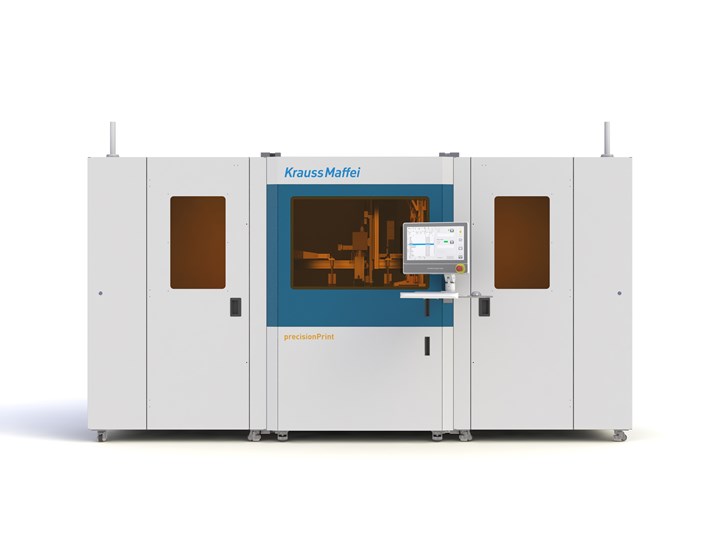KraussMaffei Launches Two Additive Manufacturing Lines at K 2022
Long established in injection molding, extrusion and polyurethane reaction process machinery, 184-yr-old KraussMaffei prepares to enter the industrial additive manufacturing market.
Plastics processing machinery company KraussMaffei (KM) used a dramatic curtain-drop at its K 2022 show booth to literally unveil its first two additive manufacturing platforms—powerPrint large-format and precisionPrint small-format machines.
According to Michael Helneder, who leads the new AM division at the company, “Our mission is to provide additive manufacturing solutions that are matched to applications, machines and materials correctly the first time,” noting that an end-to-end process that avoids potentially expensive and time-consuming optimization is a requirement for reliable industrialization of additive manufacturing.

KraussMaffei’s precisionPrint system features a resolution of 18-80 µm with a build volume of 250 x 250 x 400 mm (10 x 10 x 16 in.). (Photos: KraussMaffei)
The precisionPrint machine uses liquid resins in a UV laser-based additive manufacturing process, promising high dynamic resolution of 18-80 µm with a build volume of 250 x 250 x 400 mm (10 x 10 x 16 in.). The machine is built around dual tanks system, automated build plate changer and a long-life 405-nm industrial laser. The company says the tank system allows separation of parts building and handling.
While the precisionPrint exhibit was static, KM’s larger powerPrint system was running at the show, with samples of parts it has created for the foundry industry also on display. Described as an extruder-based gantry system, powerPrint runs standard resin pellets in a process called Fused Granulate Modeling (FGM) for components as large as 10 m3. The machine has a build volume of 2000 x 2500 x 2000 mm (79 x 98 x 79 in.).

For components as large as 10 m3, KM’s powerPrint has a build volume of 2000 x 2500 x 2000 mm (79 x 98 x 79 in.).
There are two powerPrint sizes available with output capacities up to 10 or 30 kg/hr. Customers can specify the screw design, with extruder temperatures up to 400°C/752°F for processing even high-temperature thermoplastics and nozzle sizes ranging from 2 to 20 mm. The heated vacuum print table has 16 zones, and the entire system is surrounded by a heat-resistant enclosure.
Material drying is connected with the material supply by a vacuum supply system, which KM says allows for continuous production without operator intervention. Depending on requirements, multiple mounting surfaces can be configured with a preset printing-table temperature up to 140°C/284°F. The Printcore extruder printer head is guided by linear robots from KM with a maximum travel speed of 300 mm/sec.
The user interface is based on HTML5 working in standard slicer output files, which KM says makes data preparation and print-file creation easier; data transfer from the pre-process system can be done wirelessly or via USB. The company says it will enter an intensive test phase with beta customers in 2023, after which the printers will be commercially available.
Related Content
-
New Technology Enables ‘Smart Drying’ Based on Resin Moisture
The ‘DryerGenie’ marries drying technology and input moisture measurement with a goal to putting an end to drying based on time.
-
Impacts of Auto’s Switch to Sustainability
Of all the trends you can see at NPE2024, this one is BIG. Not only is the auto industry transitioning to electrification but there are concerted efforts to modify the materials used, especially polymers, for interior applications.
-
Automotive Awards Highlight ‘Firsts,’ Emerging Technologies
Annual SPE event recognizes sustainability as a major theme.
















